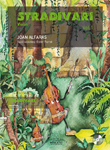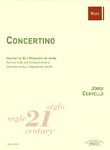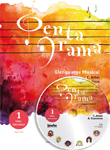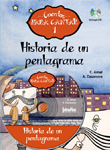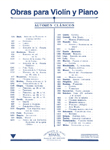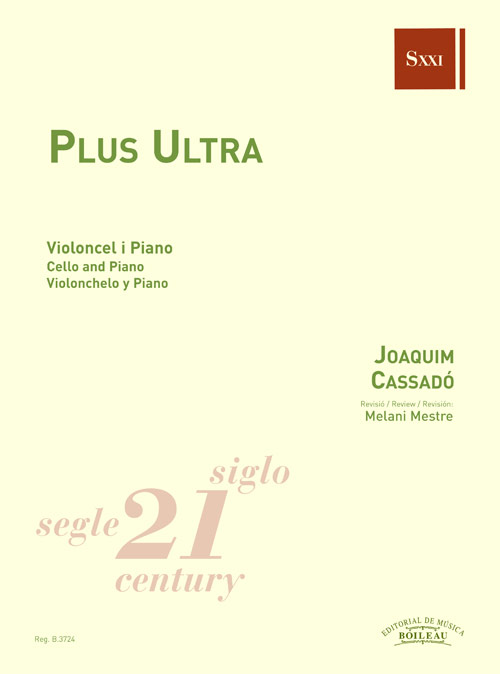Plus Ultra (Cassadó)
Violonchelo y Piano
CASSADÓ, JoaquimReg.: B.3724
17,80 €
P.V.P. (VAT included 4%)
Add to cart
- Review: MESTRE, Melani
- Ensemble: Duos: With piano.
- Genres: Classical / contemporary: Chamber.
- Product format: Partitura + particellas
- Difficulty level: Advanced-superior
- Period: 1st half S. XX
- Publishing house: Editorial Boileau
- Collection: Siglo XX
- No. of pages: 20+4
- Measure: 31,00 x 23,00 cm
- Lenght: 3' 50"
- ISMN: 979-0-3503-1779-8
- Available in digital: No
- Available for rent: No
Considering the quality and quantity of the works by Joaquim Cassadó it is incomprehensible that up to the present he remains a true mystery. Cassadó could be considered are the first great Catalan symphonist of the 19th Century and one of the first pre-coursers of Nationalism in our country. His is a Nationalism that is solidly based on central European traditions, mainly Germanic in its
Born in Mataró, Cassadó created an extensive catalogue of varied works. Most important among them are the symphonic preludes, three concertos for soloist and orchestra, two symphonies, various operas, zarzuelas, and much religious music. He was also an important composer of chamber music, although most of his works in the genre were not published. Almost all of his chamber music was conceived to be performed in the family home. Most likely this was due to the fact that Joaquim Cassadó and his two sons, Agustí and Gaspar, were recognized performers and formed a trio of violin, cello and piano, which ended with the premature death of Agustí.
Of the three, the most important figure in musical history was Gaspar, well-known as a cellist and a student of Pau Casals. Gaspar Cassadó was a special inspiration for many works by his father which were also dedicated to him. Joaquim Cassadó wrote for Gaspar, Concierto Español (Spanish Concerto), for cello and symphonic orchestra, the Sonata for cello and piano, the Cuarteto Español (Spanish Quartet), which was dedicated to the string quartet of which Gaspar was the cellist, as well as Plus Ultra.
Due the aesthetic of his works, their Nationalist sentiment as well as the voluntary exile from his country, we can see a certain relationship between Cassadó and his Russian colleague Sergei Rachmaninoff. Like Rachmaninoff, the Spanish composer knew how to adapt the instrumental techniques of other countries for his own Nationalist point of view. Thus, he used his knowledge of European musical traditions to achieve a Spanish style, in the best sense of the word. Just as Albéniz travelled to the most remote Spanish territories, evoking in his works the lost colony of Cuba, Cassadó went even further in some cases, joining together Northern and Caribbean references in one of his most important works, his fantasy Hispania for piano and orchestra.
Plus Ultra is a special case in which the desire to exhibit his deepest Nationalist sentiments took a second place to a more global style into which he incorporated harmonies and melodic turns that recall Rachmaninoff more than Albéniz. Plus Ultra can be considered as a “musical thought” which, in spite of references or paraphrases of some typical aspects of Spanish music of the era, is an authentic lied in which the cello sings out, using maximum of its expressive possibilities, with a piano accompaniment of the first order.
In this work Cassadó makes more extensive use of pianissimo, which is more typical of the French school, than in any other of his works. Through the use of gestures which are almost Impressionist, as well as refined and tasteful harmonies, the composer divides the musical discourse between the two instruments creating a fantastic work which his son Gaspar performed in concerts.
Comentaris / Comments / Comentarios
Plus Ultra: partitura / score
Biografia / Biography / Biografía

